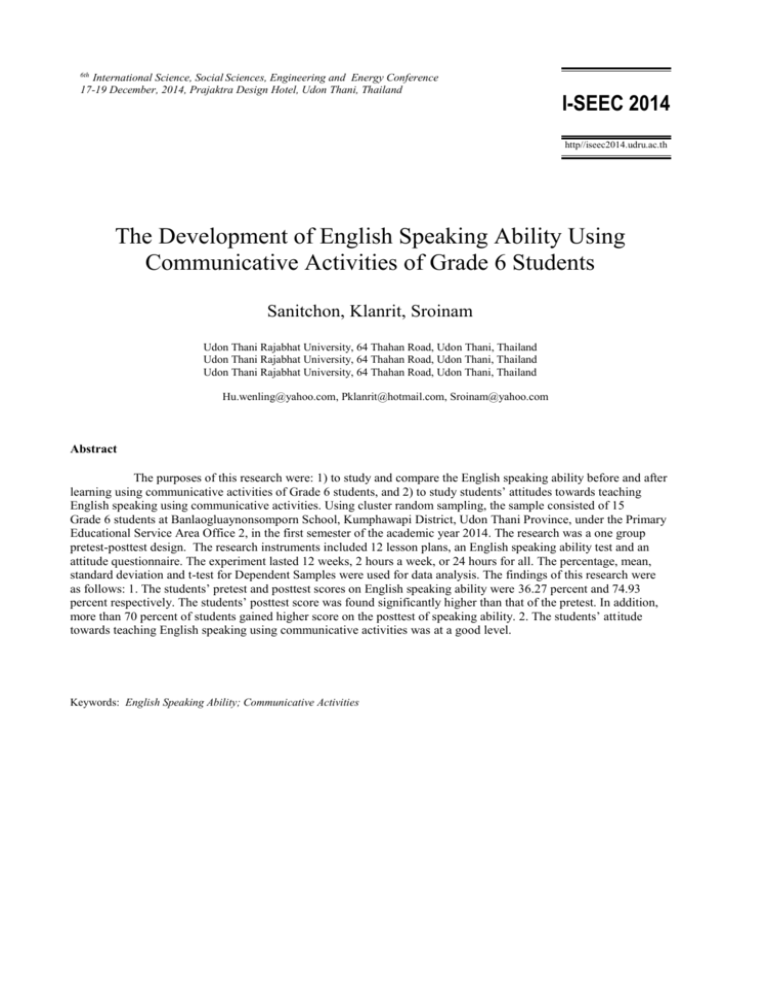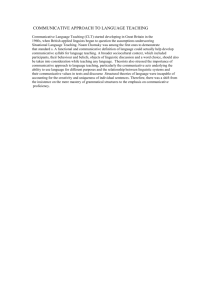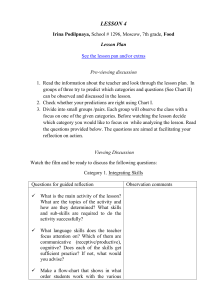Article - I
advertisement

6th International Science, Social Sciences, Engineering and Energy Conference 17-19 December, 2014, Prajaktra Design Hotel, Udon Thani, Thailand I-SEEC 2014 http//iseec2014.udru.ac.th The Development of English Speaking Ability Using Communicative Activities of Grade 6 Students Sanitchon, Klanrit, Sroinam Udon Thani Rajabhat University, 64 Thahan Road, Udon Thani, Thailand Udon Thani Rajabhat University, 64 Thahan Road, Udon Thani, Thailand Udon Thani Rajabhat University, 64 Thahan Road, Udon Thani, Thailand Hu.wenling@yahoo.com, Pklanrit@hotmail.com, Sroinam@yahoo.com Abstract The purposes of this research were: 1) to study and compare the English speaking ability before and after learning using communicative activities of Grade 6 students, and 2) to study students’ attitudes towards teaching English speaking using communicative activities. Using cluster random sampling, the sample consisted of 15 Grade 6 students at Banlaogluaynonsomporn School, Kumphawapi District, Udon Thani Province, under the Primary Educational Service Area Office 2, in the first semester of the academic year 2014. The research was a one group pretest-posttest design. The research instruments included 12 lesson plans, an English speaking ability test and an attitude questionnaire. The experiment lasted 12 weeks, 2 hours a week, or 24 hours for all. The percentage, mean, standard deviation and t-test for Dependent Samples were used for data analysis. The findings of this research were as follows: 1. The students’ pretest and posttest scores on English speaking ability were 36.27 percent and 74.93 percent respectively. The students’ posttest score was found significantly higher than that of the pretest. In addition, more than 70 percent of students gained higher score on the posttest of speaking ability. 2. The students’ attitude towards teaching English speaking using communicative activities was at a good level. Keywords: English Speaking Ability; Communicative Activities 2 1. Introduction Language has an important function in the society. It is a communication tool among people in the society. It is used for communication, study, career, building and understanding among people in the nation or across the nations and realizing various cultures around the world [1[. In the context of Thailand, English has been significant for Thai people in the present and the up-coming future. According to ]2] English is used as second language that has been emphasized on the important of English use. It has been an important language for acquiring knowledge, getting through the new events, pursuing higher education and administering business negotiation with other countries. English also plays an important role for all people in gathering valuable information through English texts from various kinds of sources. In learning and teaching English, speaking is significant for transferring knowledge and thoughts among people by using the language as a tool for communication. For all four language skills, speaking is the most important, as a productive skill. It indicates that speakers have language knowledge and help them more understanding the other skills]3[. In Thailand, English has been defined as a foreign language. Thai students generally have a few opportunities to interact with English native speakers. Moreover, speaking English is the most difficult for Thai students. They speak English ineffectively because they are not in speaking English environment for communication. The speakers also have a lack of native culture understanding [4]. It can be claimed that speaking skill is necessary for improving and developing. How to improve and develop speaking skill to student has been a tough task for English teachers. A teacher needs to seek for appropriate methods, tasks or activity to suit Thai students’ circumstances in order to improve and develop their English speaking ability. Nowadays, teaching English in Thai education still uses teacher centered method. A teacher lectures all the class. Students hardly use English or communicate with their partners or colleagues. According to [5]and[6] , students are used to listening because a teacher plays an important role in the class. They feel unconfident to asking the question that they do not understand. Moreover, a Thai teacher has pointed out the students’ grammatical competence. Importantly, learning languages do not mean learning only the grammar, but also developing the ability to communicate by speaking fluently and meaningfully. To sum up, general problems in teaching English speaking from different factors that cause limitation of speaking ability are varied and it depends on each school’s context. In order to be successful in English language leaning, especially English speaking skill, effective teaching methods and suitable learning environment need to be consider for further development and sustainability. The students at Banlaogluaynonsomporn School are not able to speak English effectively and fluently as observed in the classroom. They rarely use English for communication, their English speaking skill is about 32.50% of the score [7]. To support the result, school circumstances are not appropriate to indicators and learning standards. There is lack of fund to subsidize to teaching materials. Students also feel unconfident and fear to speaking the language. According to, communicative activities are interesting and possibly effective. Students are able to speaking English in everyday-life situation appropriately. [8] stated that communicative activities are an activity that students can use and practice English expressions and sentences under the proposed situations. Similarly, [9] in that communicative activity is the way that students can create the real use of language in everyday life. Communicative activities that the researcher used in this research were Information-gap Activity, Identifying the differences, sharing personal Information, Picture Describing, interviews and Story-telling. Moreover, the activities can facilitate students to be more enjoyable, inventive, and confident when speaking English. All in all, students are having difficulties in speaking English in terms of appropriateness, accuracy, fluency, and confidence. Regarding to these problems, to develop English speaking ability communicative activities can be implemented. 3 As the above mentioned, the researcher would like to develop students’ English speaking ability using communicative activities of Grade 6 students of Banlaogluaynonsomporn School. The researcher would also like to study whether the Grade 6 students’ English speaking posttest scores are higher than the pretest ones after using communicative activities, and at what level the students ‘attitude towards teaching English speaking using communicative activities is. 2. Objectives of the study The purposes of this research were: 1) to study and compare the English speaking ability before and after learning using communicative activities of Grade 6 students, and 2) to study students’ attitudes towards teaching English speaking using communicative activities. 3. Methodology A. Scope of the study 1) The samples The samples were 15 Grade 6 students of Banlaogluaynonsomporn School, Udon Thani, Thailand, using Cluster Random Sampling. 2) Variables Dependent Variable was teaching English speaking ability using communicative activities. Independent Variables were student’s English speaking ability and students’ attitude towards teaching English speaking using communicative activities. B. Instruments There were 3 types of instruments as follows: 1) Lesson plans using communicative activities, 2) An English speaking ability test which was used as the pretest and the posttest, and 3) An attitude questionnaire. C. Data collection Data were collected and the study was administered in the normal English classroom. An English speaking ability test was employed as the pretest. Twelve lesson plans using communicative activities were employed with 15 students. After that the Speaking test was employed as the posttest, and the students’ attitude questionnaire was used. D. Data analysis The data were analyzed quantitatively from the English speaking ability test and the attitude questionnaire. Statistics employed were percentage, Mean, Standard Deviation, and t-test for Dependent Samples. 4. Research findings The pretest mean score was 36.27 percent and the posttest mean score was 74.93 percent. The student’s English ability scores after using communicative activities were significantly higher than the prior one. Also the students’ attitude towards teaching English speaking using communicative activities was rated at a good level. 4 5. Discussion The objectives of this research were to study and compare students ‘English speaking ability between the pretest and the posttest scores after teaching English speaking ability using communicative activities of 15 Grade 6 students and the students’ attitude towards the teaching English speaking ability using communicative activities. According to the previous findings, the discussions were presented as follows. 1. To study and compare the students’ English speaking ability using communicative activities of Grade 6 students, it was found that the students’ speaking posttest score was 37.47or 74.93 percent and the pretest one was 18.13 or 36.27 percent. The posttest score was significantly higher than that of the pretest one at the .01 level. That was accordance with the research hypotheses that students’ speaking ability had developed to the set up criteria at 70 percent. As shown from the findings, teaching English speaking using communicative activities was very effective in developing the students’ English speaking ability. They enjoyed and had a lot of fun while interacting in pairs or in groups. This might be that the communicative activities provide opportunities for students to practice speaking using expressions and sentences in pairs or in groups. Moreover, the activities motivated the students to be able to produce the appropriate target language in various situations. Consequently the students were able to use the language to communicate effectively and confidently. The results were consistent with in that, communicative activities are an activity that students can use and practice English expressions and sentences under the proposed situations. Similarly, [9]in that Communicative activity is the way that students can create the real use of language in everyday life. They can also interact with other speakers in pair or group which can help students reduce anxiety and fear in speaking the language. Moreover, the communicative activities can facilitate students to be more enjoyable. They can create and produce language fluently and effectively. This was in accordance with [10], who stated that Communicative activities are the activities that they can create the language in various situations that they prefer to communicate. Also, [11] stated that communicative activities are activities that they can practice speaking English in everyday life situations. The activities are very fun and interactive. Students work in pair or group more effectively and confidently. This was also in accordance with [12] who studied the impact of using communicative activities for EFL learners in improving speaking ability. She stated that communicative activities used in two types (Information-gap and Role-play) were used to help students can create the language with other speakers. They were very fun and interactive. Students could also speak or use language effectively. Likewise [13] stated that students were able to speak English fluently after using Communicative activity. Importantly, this allowed them to relatively improve their English speaking ability. This study was in accordance with [14] who stated that communicative activity could positively make change in improving listening and speaking ability. Also, the study result s gained the consistency with [15] in that communicative activity was able to arouse students’ motivation to English speaking ability. It could help students to reduce anxiety and fear in English speaking. Moreover [16] stated that students preferred studying English speaking with communicative activity. It can be claimed that when practicing speaking English using communicative activity, students were able to use the learnt language to communicate with theirs pairs or among groups more effectively. The language that they used could be familiar with students’ daily life. After being taught by using communicative activities, the students ‘speaking posttest score was higher than the pretest one. This can be concluded that using communicative activities can motivate students in speaking English. 2. To study students’ attitude towards teaching English speaking using communicative activities, It was found that students ‘attitude towards the teaching English speaking using communicative activities and gained more confident in speaking English after instruction. Communicative activities provided the students many different situations for the language function use in daily-life. They were very fun and relaxing while they were using them. Students gained a lot of language used because the instruction was appropriate to Grade 6 students. They were able to 5 work in pairs or groups which helped one another to crate the effective conversation and practice speaking. It was also found that students enjoyed performing the activities and gained more confidence to produce the language. They also speak English than the prior one. It also stated that students eagerly studied English by using communicative activities because they have opportunities to exchange their knowledge of language in the relaxing atmosphere while practicing language. Importantly, it can be claimed that teaching English speaking using communicative activities was able to provide attitude in good level. It was consistent with [17] who stated that attitude is the important thing to learn language. Attitude is motivation to improve learning language; otherwise it is the obstacle for using the language. It can be claimed that if students have attitude in learning English, the students will grain a lot of knowledge and practice English effectively. All in all, from the result, teaching English speaking using communicative activities was able to enhance and develop students’ English speaking ability. The students could gain lots of knowledge on daily-life language functions and confidence. The students’ good attitude towards using communicative activities helped them to increase their speaking ability for daily life communication. Recommendations Recommendations are as follow: 1) To develop speaking ability, teacher should explain the objectives to students that they are able to understand what they are going to study. 2) Presenting the correct words, expressions, and sentences to students who learn the correct ones from teachers’ accent or a tape. 3) Creating good relationship among a teacher and students would be advantageous for students to decrease anxiety and build up their confidence. 4) To develop speaking ability should be implemented with students in different grades. 5) Further study in speaking ability should be implemented in other skills such as listening and writing skill. References [1[Ministry of Education. (2008). The 2008 English curriculum. Bangkok: Ministry of Education. [2[Graddol, D. (2006). English next. Retrieved 17 June 2012, from http://www.britishcouncil.org/learning-research-englishnext.pdf. [3[Ur, P. (1998). A Course in language teaching. Cambridge: Cambridge University Press. [4[Shumin, K. (1997). Factors to consider: Developing adult EFL student’s speaking abilities. English teaching forum. 35(3), 8-13. [5[Tsui, A. B. M. (1985). Analyzing input and interaction in second language classroom. RELC Journal, 16, 1, 8-32. [6[Wu, Kam-yin. (1991). Classroom Interaction and Teacher Questions Revisited. Unpublished Manuscript, Department of Curriculum Studies, University of Hong Kong. [7[Laogluaynonsomporn, 2013. School academic report. Udon Thani: Academic department Banlaoglauynonsomporn School. [8[Littlewood, W. (1983). Foreign and second language teaching. Cambridge: Cambridge University [9[Grant, N. (1988). Making the most of your textbook. London: Longman Group. [10[Harmer, J. (1983). The practice of English language teaching. 6th ed. New York: Longman Group. [11[Aungwatthanakul, S. (1997). How to teach English in a foreign language. Bangkok: Chulalongkorn University [12[Klanrit, P. (2005). Communicative activities for developing English speaking proficiency in Thailand volumn 1& 2. D. Ed (TESOL) Melbourne: The University of Melbourne. Australia. [13[Wang. (2006). Designing communicative task for college English courses. Master thesis in English language and literature, Chongqing Normal University & Yangtze Normal University, China. [14[Phisutthangkoon, K. (2012). The Use of Communicative Activities to Develop English Speaking Ability of the First Year Diploma Vocational Students. Master of Arts, Srinakharinwirot University. [15[Oradee, T. (2012). Developing Speaking Skill Using Three Communicative Activities of Matthayomsuksa 5 Students. Master of Arts, Udon Thani Rabjaphat University. [16[Setjun, P. 2013. Improving Sixth Grade Students’ Speaking Skill Through Information Gap with Different Task Types and Complexity. RMU.J. (Humanities and Social Sciences), 7(2), 43-53. 6 [17[Savignon, S. J. (1983). Communicative competence: An experiment of foreign language teaching. Philadelphia: The Center for Curriculum Development.






